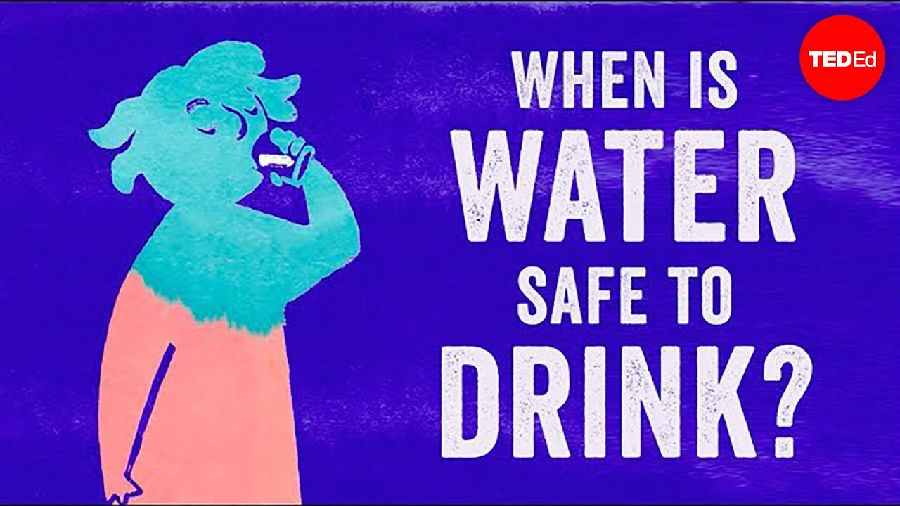(单词翻译:单击)
Take a look at the water in this glass.
我们来看一下这杯子里的水。
Refreshing, hydrating, and invaluable to your survival.
清爽又补水,对生存至关重要。
Before you take a sip, though, how do you know that the water inside is free from disease-causing organisms and pollutants?
但是在喝之前,如何确定水里没有致病微生物以及污染物呢?
One out of ten people in the world can't actually be sure that their water is clean and safe to drink. Why is that?
这世界上每10人中就有1人无法确定自己喝的水是否干净又安全。为什么?
Inadequate sanitation, poor protection of drinking water sources,
卫生系统不完备,水源保护缺失,
and improper hygiene often lead to sewage and feces-contaminated water.
以及不正确的卫生规范常常会导致污水或者受排泄物污染的水产生。
That's the ideal breeding ground for dangerous bacteria, viruses, and parasites.
这对一些有危害的细菌、病毒和寄生虫来说是一个绝佳的繁殖地。
And the effects of these pathogens are staggering.
这些病原体对人体的影响是令人震惊的。
Diarrheal disease from unsafe water is one of the leading causes of death around the world for children under five.
不安全的水所导致的腹泻是全世界5岁以下儿童群体中的一大死因。
And according to a U.N. report from 2010, microbial water-borne illnesses killed more people per year than war.
一份联合国2010年报告显示,每年,以水为传播媒介的微生物疾病造成的死亡人数甚至超过战争。
Proper treatment processes, though, can address these threats.
但是,一些正确处理水的步骤可以让我们躲过这些威胁。
They usually have three parts: sedimentation, filtration, and disinfection.
这其中包括三部分:沉淀,过滤以及消毒。
Once water has been collected in a treatment facility, it's ready for cleaning.
一旦水被收集在处理设备中,就可以开始净水了。
The first step, sedimentation, just takes time.
第一步,沉淀,这只需要时间。
The water sits undisturbed, allowing heavier particles to sink to the bottom.
水被静置,使较重的颗粒沉淀到水池底部。
Often, though, particles are just too small to be removed by sedimentation alone and need to be filtered.
但很多情况下,这些颗粒都太小了,通过沉淀无法完全去除,需要进一步过滤。
Gravity pulls the water downward through layers of sand that catch leftover particles in their pores,
重力使得水向下流过一层层沙子,这些剩余的颗粒便被留在了沙子的孔隙中,
prepping the water for its final treatment, a dose of disinfectant.
为净水的最后一步做好了准备,一剂消毒剂。
Chemicals, primarily forms of chlorine and ozone, are mixed in to kill off any pathogens and to disinfect pipes and storage systems.
使用主要由氯气和臭氧等化学物质构成的消毒剂,杀灭所有的病原体,消毒水管和储水系统。
Chlorine is highly effective in destroying water's living organisms,
氯气可以有效杀灭水中的微生物,
but its use remains government-regulated because it has potentially harmful chemical byproducts.
但是氯气的使用仍然受到政府的管制,因为它会产生具有潜在危害的化学副产品。
And if an imbalance of chlorine occurs during the disinfection process, it can trigger other chemical reactions.
一旦在消毒过程中氯气使用过多或过少,这就会引发别的化学反应。
For example, levels of chlorine byproducts, like trihalomethanes, could skyrocket,
例如,氯的副产品三卤甲烷,其含量会剧增,
leading to pipe corrosion and the release of iron, copper, and lead into drinking water.
从而腐蚀水管,铁、铜等元素会被释放进饮用水中。

Water contamination from these and other sources including leaching, chemical spills, and runoffs,
水污染还会在这样或那样的源头产生,包括农药渗流、化学物质排放以及各种径流污染,
has been linked to long-term health effects, like cancer, cardiovascular and neurological diseases, and miscarriage.
这些水污染与一些长期健康危害有关,比如说癌症、心血管疾病以及精神损伤,还有流产。
Unfortunately, analyzing the exact risks of chemically contaminated water is difficult.
不幸的是,想要分析出喝了这被化学物质污染的水将会带来哪些确切危害是很困难的。
So while it's clear that disinfectants make us safer by removing disease-causing pathogens,
尽管消毒可以把致病病原体都消灭,让我们喝的水更安全,
experts have yet to determine the full scope of how the chemical cocktail in our drinking water really impacts human health.
专家们还没有能够确定饮用水中的化学物质可以在多大程度上影响我们的健康。
So how can you tell whether the water you have access to, whether from a tap or otherwise, is drinkable?
那么,如何分辨身边现有的水是否适合饮用呢?
Firstly, too much turbidity, trace organic compounds,
首先,浑浊度过高,微量有机化合物过多,
or high-density heavy metals like arsenic, chromium, or lead, mean that the water is unsuitable for consumption.
或者含有高浓度的砷、铬、铅等重金属,意味着它不适合饮用。
A lot of contaminants, like lead or arsenic, won't be obvious without tests,
许多污染物,例如铅和砷,不通过测试是看不出来的,
but some clues, like cloudiness, brown or yellow coloration, a foul odor,
但是有一些小线索,比如说浑浊,液体呈棕色或黄色,散发难闻的气味,
or an excessive chlorine smell can indicate the need to investigate further.
或者明显的氯气味,告诉我们这时需要进一步测试。
Water testing kits can go a step further and confirm the presence of many different contaminants and chemicals.
水污染测试用具可以帮助我们证实各种污染物和化学物质的存在。
With many types of contamination, there are ways of treating water where it's used instead of close to its source.
面对各种污染,人们很多时候选择在用水环节净化而非从水源地着手。
Point-of-use treatment has actually been around for thousands of years.
这种在用水环节净的方法已经存在几千年了。
Ancient Egyptians boiled away many organic contaminants with the sun's heat.
古埃及人用太阳照射的热量蒸发掉水中很多有机污染物。
And in Ancient Greece, Hippocrates designed a bag that trapped bad tasting sediments from water.
在古希腊,希波克拉底设计出了一种过滤袋,把水中的异味沉淀物留在袋子里。
Today, point-of-use processes usually involve ionization to lower mineral content.
现如今,在用水环节净水,通常使用的是电离法,以此来降低水中矿物质含量。
They also use adsorption filtration,
或者用吸附过滤法,
where a porous material called activated carbon strains the water to remove contaminants and chemical byproducts.
有一种叫活性炭的孔状材料,它可以过滤出水中的污染物和化学副产品。
While it's not always an effective long-term solution, point-of-use treatment is portable, easy to install, and adaptable.
尽管这不是一种有效的长期策略,但是它轻便,安装方便,并且适应各种环境。
And in regions where large-scale systems are unavailable,
有些地区没有大规模的净水系统,
or where water has been contaminated further along its journey, these systems can mean the difference between life and death.
或者水在运输过程中就被污染了,那么这时候,这些轻便的净水设施就可以决定着人们的生死。
Clean water remains a precious and often scarce commodity.
干净的水至今依然是一种宝贵又稀有的资源。
There are nearly 800 million of us who still don't have regular access to it.
地球上有8亿人还不能每天喝上干净的水。
The good news is that continued developments in water treatment,
好消息是,不断进步的水处理技术,
both on a large and small scale, can alleviate a lot of unsafe conditions.
无论是大范围的还是小范围的,已经可以减缓很大一部分不安全的因素。
Implementing proper systems where they're needed and paying careful attention to the ones already in place
在有需要的地方配置净水系统,对已投入使用的净水系统进行维护,
will fulfill one of the most basic of our human needs.
这简单的两件事就可以满足我们人类最基本的需求之一了。


